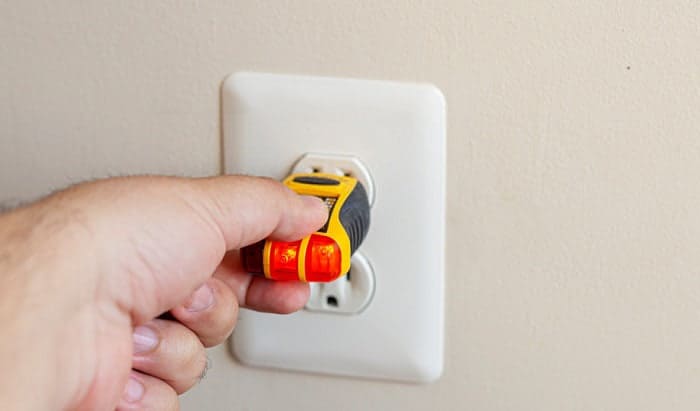Do your Ground Fault Circuit Interrupters keep you worried about the service they provide? If so, you might have a faulty one that no longer protects you from electrical hazards. Learning how to tell if a GFCI breaker is bad is important for you and your family’s protection.
The following information will serve as your in-depth guide to determining a bad GFCI outlet. This step-by-step process aims to remind you to take immediate action once your GFCI doesn’t trip anymore whenever a ground fault occurs.
Table of Contents
What You Will Need
Before we proceed to the troubleshooting techniques, you should acquire the following tools first. You can’t test a GFCI breaker barehanded since you need some piece of technology and safety equipment for electric matters.
Voltage Tester
This tool’s purpose is to determine if an outlet has electricity flowing in it or trace the responsible breaker for your GFCI. It is best to use a non-contact voltage tester for safety because you’ll never have to touch any live wires.
This pen-looking equipment can quickly determine your GFCI breaker’s condition. When it comes to contact with a live outlet receptacle or wires, it lights up or creates a beeping sound.
Since you’re trying to work on a GFCI outlet, it is best to use a 3-prong voltage tester like the Klein Tools RT210 Outlet Tester. This tester is the kind of equipment that’s plugged in and instantly lets you know if there’s a flow of electricity or not. This tester can determine if the problem of your GFCI came from incorrect wiring or the outlet itself.
Protective Footwear
In case of a bad GFCI breaker situation, you need to protect yourself from the dangers of shock and electrocution. You can usually locate GFCIs in areas with a vast amount of moisture or water puddles present. It would be best if you protect your foot with insulated shoes or boots.
Severe electrical ground accidents happen when you are barefooted, allowing the current to flow through your body as a pathway to reach the ground. The American National Standards Institute’s (ANSI) approved footwear is best for electrical works.
Protective Gloves
Your hands are the part of your body exposed first and foremost when testing the GFCI breaker. Common injuries like Arc Blast and Arc Flash could permanently damage the skin, tissues, or bones of your working hand.
Do not underestimate the possible dangers, even if you’re only going to touch the test button of the breaker or tweak some adjustments inside the main breaker panel.
Always think about the worst-case scenario and wear gloves that can support high voltages. Rubber insulating gloves that pass the Occupational Safety and Health Administration (OSHA) requirements are advisable. You can also add an extra layer of protection by wearing a leather protector glove above the rubber.
How to Tell If GFCI Breaker is Bad & Steps on Checking Your GFCI Breaker
There are two types of GFCI outlets, the Self-Testing, and the Manual-Testing. Although you can test both manually, self-testing GFCI has a LED light on the bottom of the receptacle. It is best to always look out for this green light indicator because once it turns red, you will need a replacement.
On the other hand, you can manually test your breaker. Troubleshooting GFCI is uncomplicated, and I’m confident enough to say that you can do it yourself.
For a detailed explanation to check a GFCI breaker, take note of the following steps below.
Step 1: Examine the power situation
Use your voltage tester to see if there’s an occurring current on the outlet you are testing. If the tester lights up, this indicates that the outlet has a flowing current, but if you reset it and it doesn’t trip (the tester stays on), this means you have a bad outlet.
Your tester will also inform you if your GFCI outlet has faulty wiring; if this happens, call a professional electrician and let him do the rest.
Push the test button included in the breaker itself and let it trip.
The neutral wire of the breaker connects through the panel’s neutral bus, which separates other neutral cables going around the house. The breaker trips because the test button short circuits the neutral wire to the neutral bus, creating a ground fault.
Now, you can tell if the GFCI breaker is good if the button moves and shuts off the electricity inside the outlet.
The reset button acts as a switch for power restoration in your GFCI outlet. If you’re unable to reset the breaker, this means that the power did not come back.
If all the GFCI have the same situation, you can locate the problem in the main electrical panel. Still, if it’s only one that experiences this situation, the outlet is terrible and needs an immediate replacement.
Pro Tips:
A GFCI breaker or outlet typically lasts for 15 years, depending on the use. You should check it once a month and search for bad GFCI symptoms and change it every decade.
Overloading is highly problematic, for you may experience an early failure and overheating that can melt plastic. In the same situation, overusing the breaker can lead to loose wirings due to constant plug and pull movements.
Although GFCI outlets are standard in wet places or outdoors, remember that the contacts aren’t rust-proof and still need protection from moisture exposures. It’s best if you provide a tight cover that can withstand extreme weather and protect the GFCI.
Conclusion
Did you enjoy reading this tutorial? Consider your earned knowledge on how to tell if a GFCI breaker is bad as a step towards safety. You won’t know how long your GFCI will last if you don’t check it, and if one day you’re unaware that it’s already faulty, you’ll pay for the consequence.
Is there anything worth mentioning that I missed in this tutorial? You can join the discussion and share your thoughts and comments down below. If you find this article helpful, share it with your friends and family too!

I am Andrew Wright. With 8 years of experience designing, installing, and maintaining electrical power systems. I love my job, and I have always wanted to offer others the necessary help so they can take care of their houses.



